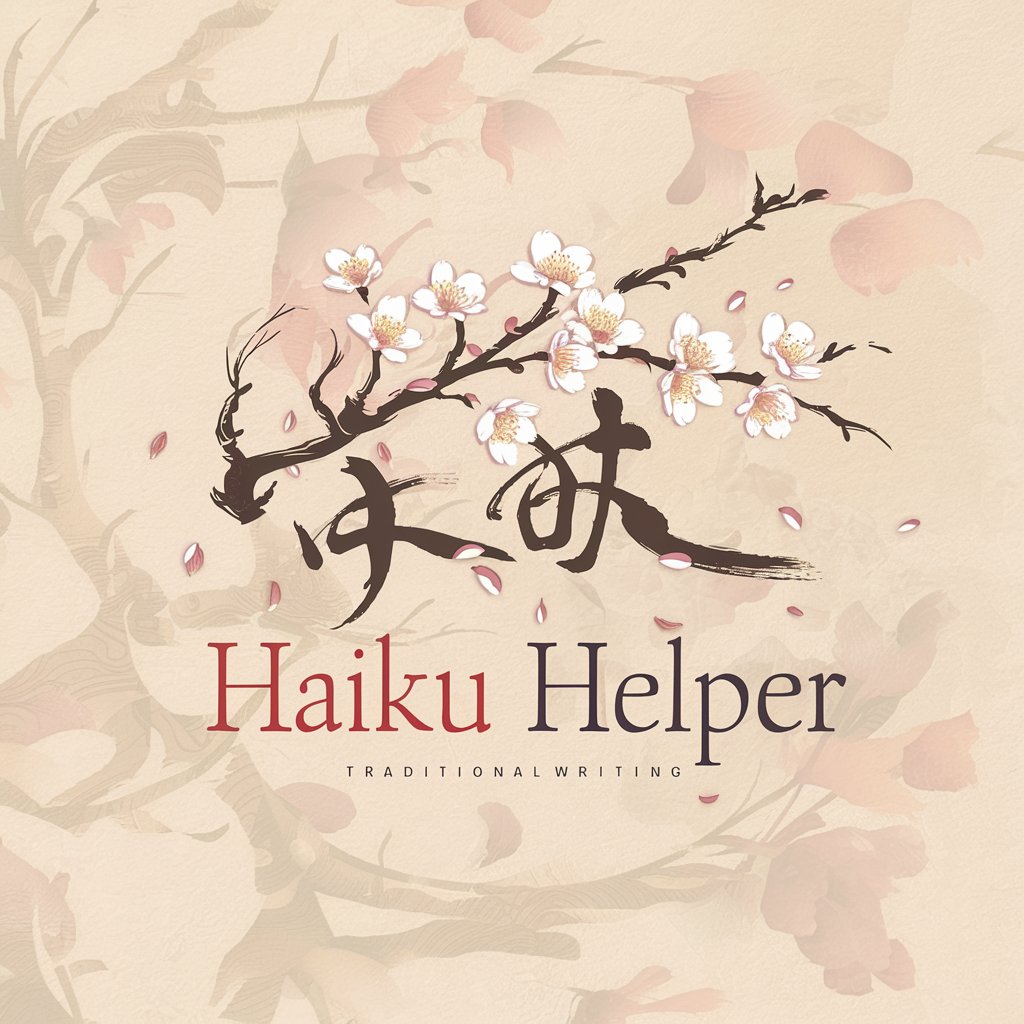Haiku Helper - Haiku Translation and Education

Welcome! Let's explore the beauty of Haiku together.
Unlocking Haiku Beauty with AI
Translate the following Haiku into English and explain its meaning:
Can you provide a word-by-word translation for this Haiku?
Please transcribe this Haiku into Romaji and explain its structure.
Give me a brief history of the poet who wrote this Haiku:
Get Embed Code
Overview of Haiku Helper
Haiku Helper is a specialized tool designed to assist users in understanding and translating Japanese Haiku poems into their native language. The core of Haiku Helper lies in its ability to accurately transcribe Haiku written in Hiragana or Katakana into Romaji while maintaining the traditional 5-7-5 or 5-7-5-7-7 syllable structure. Alongside transcription, it offers a detailed word-by-word translation, elucidating the meaning of each Japanese word in the target language. This feature aids users in grasping both the literal and the poetic nuances embedded within the Haiku. Furthermore, Haiku Helper translates the overall essence of the Haiku while striving to preserve the original syllable count, thus providing a deeper insight into the cultural and linguistic aspects of these traditional Japanese poems. Powered by ChatGPT-4o。

Key Functions of Haiku Helper
Romaji Transcription
Example
Transcribing '古池や蛙飛び込む水の音' to 'Furuike ya kawazu tobikomu mizu no oto'
Scenario
Used when a user encounters a Haiku in Hiragana/Katakana and requires a phonetic understanding in Romaji.
Word-by-Word Translation
Example
Translating '古池や蛙飛び込む水の音' as 'Old pond (furuike), frog (kawazu), jumps in (tobikomu), sound of water (mizu no oto)'
Scenario
Helpful for users seeking to comprehend each Japanese word's meaning in their native language.
Overall Haiku Translation
Example
Translating '古池や蛙飛び込む水の音' into English while preserving the syllable count: 'Ancient pond, A frog leaps in, Sound of the water'
Scenario
Useful for users desiring to understand the full Haiku in a coherent, poetic form in their native language.
Cultural and Linguistic Insight
Example
Explaining the significance of nature and momentariness in Haiku through specific poem analysis.
Scenario
Beneficial for users interested in the cultural depth and poetic techniques used in Haiku.
Target User Groups for Haiku Helper
Language Learners
Individuals learning Japanese who wish to improve their understanding of the language and culture through poetry. Haiku Helper aids in comprehending complex poetic structures and vocabulary.
Literature Enthusiasts
People with an interest in poetry, especially Haiku, who seek a deeper understanding of its nuances, cultural significance, and linguistic beauty.
Educators and Students
Teachers and students in literary or language courses can use Haiku Helper to explore Haiku in classroom settings, enhancing learning through interactive and detailed translations.
Cultural Researchers
Researchers focusing on Japanese culture or literature who require in-depth translation and understanding of Haiku and its place in Japanese society.

How to Use Haiku Helper
1
Start by visiting yeschat.ai for a seamless trial experience without the need for login or subscribing to ChatGPT Plus.
2
Type your Haiku or Haiku-related query into the chat interface. Haiku Helper can assist with translations, interpretations, and educational insights.
3
For Haiku translations, please provide the original Haiku in Japanese (Hiragana, Katakana, or Kanji). Specify if you seek a literal translation, a poetic rendition, or both.
4
Use Haiku Helper to learn about Haiku structure (5-7-5 syllable pattern), famous poets, and historical context by asking specific questions.
5
Explore creative applications by generating Haiku based on themes or emotions you provide, enhancing your understanding and appreciation of this poetic form.
Try other advanced and practical GPTs
Universal Poetic Painter v2
Visualizing Poetry Across Languages with AI

Universal Poetic Painter
Bringing Poetry to Life with AI-Powered Art

江恩理论 (Gann Theory)
Empowering market predictions with AI-driven Gann Theory

艾略特波浪理论(Elliott wave principle)
Decipher Market Trends with AI

Master Pixel Architect
Crafting Pixel-Perfect Buildings with AI

道氏理论 (Dow Theory)
Empowering Investments with AI & Dow Theory

Tech Service Agreement Drafting Expert
Streamline Your Contract Creation with AI

Technical Service Agreement Review Expert
Simplify contract reviews with AI-powered analysis.

Expert in Legal Review of Influencer Agreements
Simplify Influencer Agreements with AI

General Service Agreement Drafting Master
Streamlining Agreement Creation with AI

General Service Agreement Review Master
Streamlining contract reviews with AI power

SaaS Agreement Drafting Master
Streamlining SaaS Agreements with AI

Frequently Asked Questions about Haiku Helper
Can Haiku Helper translate Haiku from English to Japanese?
Yes, Haiku Helper can translate Haiku from English to Japanese, offering both a literal translation and a version that maintains the original 5-7-5 syllable count, focusing on preserving the essence and structure of the Haiku.
Does Haiku Helper provide information on Haiku poets and history?
Absolutely. Haiku Helper can offer insights into the lives of famous Haiku poets, historical context, and the evolution of Haiku as a poetic form, enriching your understanding of its cultural significance.
How accurate is the Romaji transcription provided by Haiku Helper?
Haiku Helper strives to provide accurate Romaji transcriptions of Japanese Haiku, facilitating a better understanding of pronunciation and meter for non-Japanese speakers.
Can I use Haiku Helper for educational purposes?
Definitely. Haiku Helper is an excellent tool for educators and students alike, providing detailed explanations of Haiku structure, translations, and cultural context, making it a valuable educational resource.
Is it possible to get help with writing my own Haiku?
Yes, Haiku Helper can assist you in crafting your own Haiku by providing guidelines on structure, thematic inspiration, and feedback on your attempts, fostering your poetic creativity.
